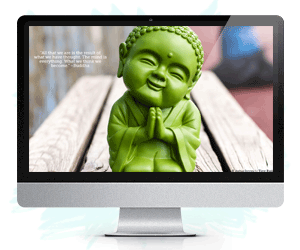
“When we are no longer able to change a situation, we are challenged to change ourselves.” ~Viktor Frankl
It started as a faint hum—a sense of unease that crept in during the isolation of the pandemic. I was a licensed therapist working from home, meeting with clients through a screen. Together, we were navigating a shared uncertainty, trying to cope as the world shifted beneath us.
I could feel the weight of their anxiety as they talked about their spiraling thoughts and struggles to feel grounded. What I didn’t realize then was how much of their turmoil was a reflection of my own.
During those months, I gave my clients all the tools I knew. We talked about mindfulness, grounding exercises, and ways to reconnect with a sense of safety. But the truth? These conversations often felt hollow. It wasn’t that the tools didn’t work in theory—it was that they didn’t land in the body. Fear, disconnection, and panic had rooted themselves deeper than words could reach.
I began to think, “What would it take for us to truly feel safe again—not just talk about it?” That question became the seed of a larger realization, one that would shift my focus entirely.
The Missing Piece
Years ago, when I first trained as a therapist, I learned about bilateral stimulation (BLS). At its core, it’s a method of gently guiding the brain to process emotions through rhythmic left-right movement. You’ve probably done it yourself, without realizing it—tapping each knee while stressed or walking back and forth to clear your head.
Clinically, BLS is used in therapies like EMDR (Eye Movement Desensitization and Reprocessing), which helps people process trauma in a way that feels safer and more contained.
The science behind it is remarkable, but what truly struck me was how intuitive it felt. Trauma often leaves us stuck—in our minds, in our bodies, and in our fight-or-flight response. BLS created subtle shifts, allowing people to process without getting overwhelmed. It was a solution that existed not just in the mind but also in the nervous system.
Still, I hesitated to fully explore using it beyond therapy rooms. My focus was on the tools within my comfort zone—strategies, worksheets, and techniques that worked well enough. But everything changed when the hurricane hit.
When Trauma Becomes Personal
Hurricane Helene arrived when we were already worn thin. My community in Western North Carolina was still grappling with the fallout of the pandemic, and now, this immense storm came to claim what little stability we had left.
The destruction wasn’t just physical—it was emotional. Entire neighborhoods were uprooted, including mine. I found myself not as a therapist observing trauma, but as a human immersed in it. Days turned into weeks of survival mode. Displaced families. Empty cupboards. Sleepless nights listening to the rain pound against temporary roofs. My own nervous system was in constant overdrive—frozen between fear and exhaustion.
And yet, in the fragmented moments of stillness, I noticed something. Healing wasn’t happening in grand gestures or revelations. It was in the small, quiet choices to keep moving forward—packing what I could salvage, helping a neighbor clear debris, or holding my daughter’s hand as we waited in line for supplies. It struck me how easy it is to feel powerless after trauma. Everything feels broken. But healing isn’t about fixing everything at once. Sometimes, it starts with reshaping one moment.
Lessons from the Debris
Trauma changes us. It rewires not only how we view the world but also how we feel within it. I’ve worked with countless clients stuck in the aftermath of trauma—unable to sleep, flooded by overthinking, fearing everything will fall apart again. I thought I understood what it meant to feel this way. Living through the hurricane taught me just how layered and consuming it can be.
What I learned, though, is that healing is possible. It doesn’t come with a single moment of clarity but rather through consistent, small acts of care. Here are the lessons I carried from that time, ones that I hope may help you too if you’re feeling stuck in survival mode.
1. Your body speaks—start listening.
Trauma often lives in the body long after the event has passed. It’s easy to ignore the signals your body sends—tightness in the chest, a restless mind, or even chronic fatigue. But healing starts with awareness.
Take note of how you physically feel when panic strikes. Are your shoulders tense? Is your breathing shallow? Engage in small practices to reset your body’s rhythm, like walking, stretching, or even tapping your hands alternately on your thighs.
2. Safety is built, not found.
After trauma, our nervous systems often stay in survival mode, scanning for the next threat. This makes it hard to trust—others, ourselves, or even moments of calm. Rebuilding a sense of safety takes time and consistency.
Find routines that ground you, like starting your day with a cup of tea or ending it with journaling. These rituals remind your nervous system that you’re not in immediate danger anymore—that it’s okay to exhale.
3. Healing requires community.
One of the hardest things about trauma is the isolation it brings. Whether it’s pride, shame, or sheer exhaustion, it often feels easier to close yourself off. But connection is where healing happens.
During the aftermath of the hurricane, it was the smallest gestures from community members—sharing meals, checking in, or listening—that reminded me I wasn’t alone. Don’t be afraid to reach out or accept help, no matter how small it feels.
4. Reset as many times as you need.
Healing isn’t linear. You’ll have good days and hard ones, moments of clarity followed by setbacks. That’s okay. The key is learning to pause when you need to rather than pushing through. Whether it’s a deep breath, a short walk, or time to process your emotions, each pause is a chance to reset and start again.
Moving Forward, One Step at a Time
The hurricane didn’t just strip away homes—it also stripped away my old idea of what it means to heal. I used to think it was something that happened after the chaos subsided, when everything was back in order. But I’ve learned that healing works differently. It happens in the middle of the mess, through small, brave acts that remind you you’re still here. You’re still trying.
Whether you’ve lived through a storm, a personal loss, or a chapter filled with uncertainty, know this: healing isn’t about the destination. It’s about the choices you make in the moment—the choice to pause, to breathe, to ask for help, or to forgive yourself for not having it all figured out. One quiet, powerful choice at a time, you can rebuild.
About Erin Vandermore
Erin Vandermore is a licensed clinical mental health counselor and founder of Helene Therapy Network. Drawing on her personal experiences with trauma and her work as a therapist, Erin shares insights to inspire healing and resilience. When not working on mental health initiatives, she loves hiking in the mountains of Western North Carolina. You can connect with her on @mindcircuitapp, or read more of her work at mindcircuit.org.













 Though I run this site, it is not mine. It's ours. It's not about me. It's about us. Your stories and your wisdom are just as meaningful as mine.
Though I run this site, it is not mine. It's ours. It's not about me. It's about us. Your stories and your wisdom are just as meaningful as mine. 